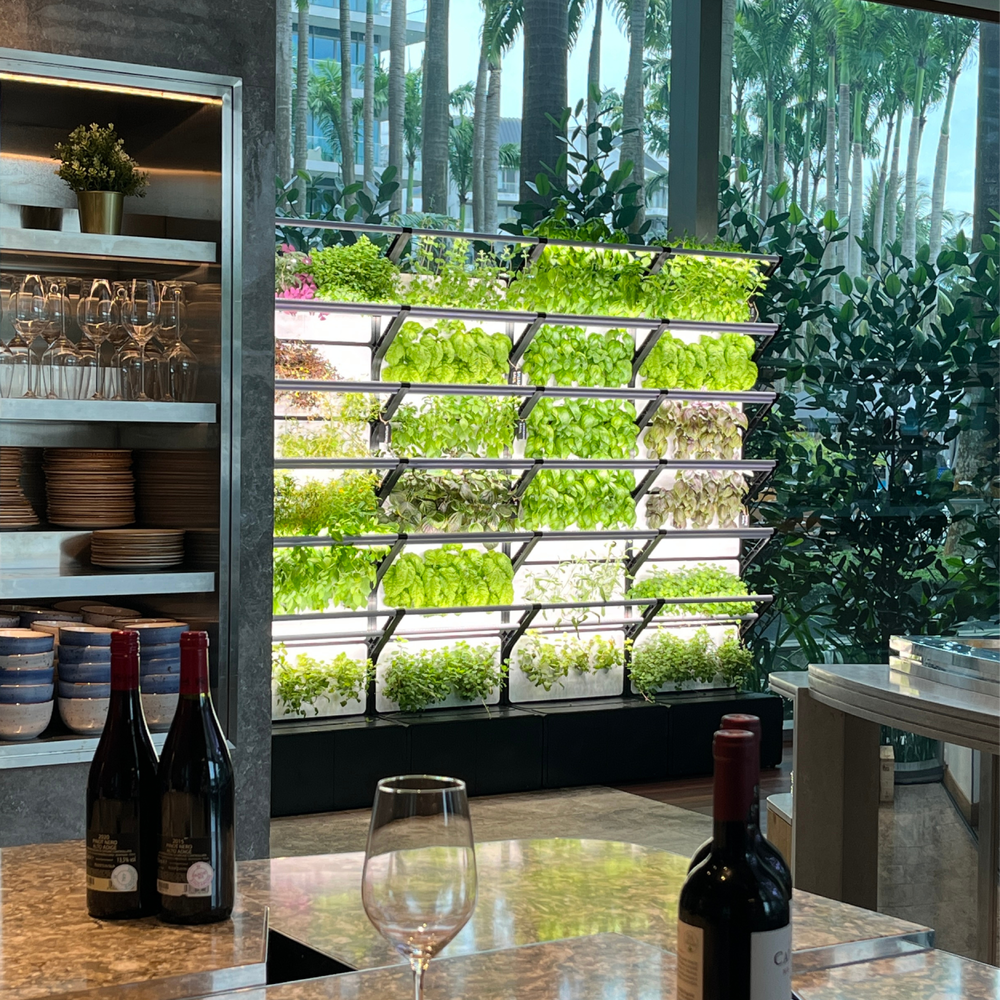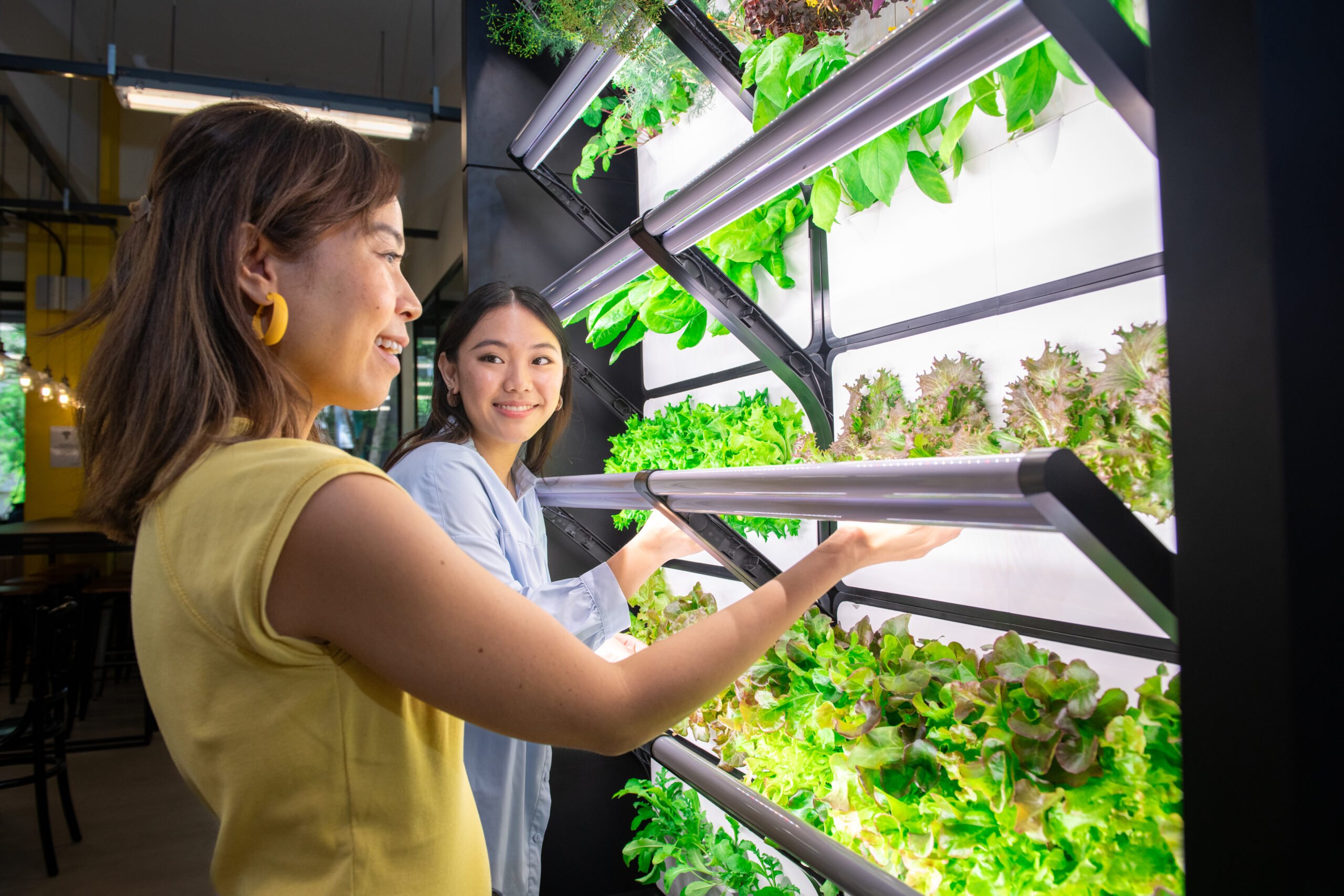- back to resources
- Getting Certified In Corporate Real Estate with Urban Farming
- back to resources
- GROBRIX BLOG
- Getting Certified In Corporate Real Estate with Urban Farming
Getting Certified In Corporate Real Estate with Urban Farming
- ,
-
Grobrix

In the corporate real estate sector, sustainability and occupant well-being are increasingly critical priorities. Certifications such as Leadership in Energy and Environmental Design (LEED), BCA Green Mark, and WELL provide frameworks to achieve these goals, each with distinct focuses and applications. To kick off, here is a summary that explores their origins, criteria, and impact on corporate real estate, highlighting their role in driving sustainable and healthy building practices. After that, in collaboration with the KaiCari Impact Group, we’ll explore how the simple act of bringing urban farming into corporate real estate can provide an efficient and cost effective way to help achieve these certifications.
LEED Certification
LEED, developed by the U.S. Green Building Council (USGBC) in 1993, is the world’s most widely recognized green building rating system, applied in over 186 countries with more than 195,000 certified buildings as of 2024. LEED provides a comprehensive framework for designing, constructing, and operating sustainable buildings, emphasizing energy efficiency, water conservation, waste reduction, and indoor environmental quality. It is applicable to various project types, including commercial offices, data centers, and retail spaces, making it highly relevant for corporate real estate.
LEED certification is awarded at four levels—Certified (40–49 points), Silver (50–59 points), Gold (60–79 points), and Platinum (80+ points)—based on a 100-point scale, plus 10 bonus points for regional priorities or innovation. Projects earn points across categories like sustainable sites, energy efficiency, materials selection, and indoor environmental quality. For corporate real estate, LEED’s Building Design and Construction (BD+C) and Operations and Maintenance (O+M) rating systems are particularly relevant. BD+C supports new constructions and major renovations, while O+M focuses on optimizing existing buildings’ performance.
In corporate settings, LEED certification enhances property value, reduces operating costs, and aligns with Environmental, Social, and Governance (ESG) goals. For example, a 2021 USGBC report noted that LEED-certified office properties attract higher leasing rates and perform well for investors focused on ESG objectives.
BCA Green Mark Certification
Launched in 2005 by Singapore’s Building and Construction Authority (BCA), the BCA Green Mark is a green building rating system tailored to Singapore’s tropical climate and urban context, though it has influenced sustainable practices in countries like Malaysia and China. It evaluates buildings based on energy efficiency, water efficiency, environmental protection, indoor environmental quality, and other green innovations. Certification levels include Certified, Gold, GoldPLUS, and Platinum, determined by a points-based system.
Green Mark’s focus on energy efficiency is particularly impactful. Retrofitted buildings meeting Super Low Energy (SLE) standards are 63% more energy-efficient, with new SLE buildings achieving investment payback in as little as 4.5 years. The certification process involves submitting applications, pre-assessment audits, and documentary reviews, with higher ratings like GoldPLUS and Platinum requiring panel assessments. For corporate real estate professionals, Green Mark enhances property marketability and supports Singapore’s net-zero emissions goal by 2050, though its regional specificity limits global applicability compared to LEED.
WELL Certification
The WELL Building Standard, introduced by the International WELL Building Institute (IWBI), focuses exclusively on human health and well-being, addressing air, water, nourishment, light, fitness, comfort, and mind. Unlike LEED and Green Mark, which prioritize environmental sustainability, WELL targets occupant health, making it a complementary certification for corporate real estate aiming to enhance workplace productivity and employee satisfaction.
WELL certification is structured around ten concepts, setting performance-based requirements to create healthier indoor environments. In corporate offices, WELL-certified spaces improve air quality, optimize lighting, and promote mental well-being, which can reduce absenteeism and boost morale. WELL’s niche focus on health can make it less comprehensive for environmental sustainability, so it is sometimes integrated with a LEED certification for a more holistic approach. The certification process involves expert guidance to meet WELL’s rigorous standards.
Applications and Impact in Corporate Real Estate
In corporate real estate, these certifications drive competitive advantages. LEED enhances global marketability, reduces utility costs (20–30% energy savings), and aligns with investor ESG priorities. Green Mark is critical in Singapore, boosting occupancy rates and supporting national sustainability goals, with tangible financial returns through energy savings. WELL prioritizes employee health, fostering productive workplaces, which is increasingly vital as companies compete for talent.
Challenges include certification costs, complexity, and regional applicability. LEED’s global reach contrasts with Green Mark’s Singapore-centric focus, while WELL’s health emphasis requires integration with broader sustainability frameworks. Corporate real estate professionals must align certifications with project goals, local regulations, and market demands. Together, LEED, Green Mark, and WELL transform corporate real estate by promoting sustainability, health, and economic benefits. As global and regional sustainability targets tighten, these certifications will remain pivotal in shaping high-performing, occupant-centric buildings.
How can Indoor Urban Farming help?

So as it turn’s out, Grobrix edible green walls are a powerhouse for racking up points for these certifications, whilst at the same time turning corporate spaces into sustainable, feel-good hubs. Here’s how it’s done!
For WELL v2, indoor farming like Grobrix’s urban farms hits multiple concepts. In Nourishment, on-site greens ensure daily access to fresh produce, meeting pre-conditions and earning points for nutrition education via harvest workshops and healthy food promotion through signage. Food Production credits come from edible gardens yielding kilos of greens weekly, while Local Food Environment is satisfied by produce grown right in the office. In Mind, green walls act as natural elements for mental respite, supporting pre-conditions and restorative spaces. Movement gets a boost from active harvest sessions, encouraging staff to ditch desks. A Grobrix vertical farm can unlock up to 20% of WELL Gold points, fostering wellness with every leaf. Here is that broken down in more detail.
| WELL concept → feature | What the feature asks for (abridged) | How Grobrix satisfies it | Points unlocked* | Typical evidence |
| Nourishment – N01 Fruits & Veg (Pre-condition) | Provide visible, ready access to fruit/veg every day | On-site wall lets employees self-harvest pesticide-free greens all day | Pre-condition met | Dated photos of stocked wall; maintenance log showing ≥ daily availability WELL Certified |
| Nourishment – N04 Food Advertising (Opt.) | Promote healthy options; restrict unhealthy ads | Branded signage, QR recipes, Teams/Slack nudges | 1 pt | Signage photos; intranet screenshots |
| Nourishment – N07 Nutrition Education (Opt.) | Monthly education on healthy eating | Fortnightly harvest & “farm-to-table” workshops | 1 pt | Workshop calendar, decks, sign-in sheets |
| Nourishment – N12 Food Production (Opt.) | ≥ 0.1 m²/occupant gardens or 50 L edible plants on-site | 6-unit wall ≈ 600 L substrate & > 6 kg greens/week | 1–2 pts | Planting schedule; yield log |
| Nourishment – N13 Local Food Environment (Opt.) | Produce source within 800 m | Wall on premises fulfils distance rule | 1 pt | Site plan |
| Mind – M02 Nature & Place (Pre-condition) | Incorporate natural elements and local ecology | Living wall with seasonal crops | Pre-condition met | Species list; photos |
| Mind – M04 Restorative Spaces (Opt.) | Spaces for mental respite with nature views | Seating facing wall or harvest corner | 1 pt | Floor plan; photo log |
| Movement – V02/V05 Active Furnishings & Amenity Programming (Opt.) | Encourage movement; break sedentary behaviour | Standing harvests, “pick-your-salad” lunch walks | 0.5–1 pt | HR comms; event photos |
*Points vary by project type and whether you pursue Core or Full certification.
Total WELL boost: 6–8 optimisation points + 2 pre-conditions (≈ up to 20 % of WELL Gold)
LEED v4.1 loves indoor farming’s eco-edge. In Environmental Quality, green walls near windows count as quality views, enhancing occupant comfort. Innovation credits are earned through local food production, with logged yields proving impact, and green building education via signage and tours. These efforts can contribute up to 5% of LEED Gold points, cutting carbon and waste while making offices feel alive.
2 LEED v4.1 – key credits Grobrix supports (ID+C Interiors or O+M)
| LEED credit | What the credit asks for (abridged) | How Grobrix satisfies it | Points unlocked* | Typical evidence |
| EQ Credit – Quality Views | ≥ 75 % of regularly-occupied floor area must enjoy “quality views”; interior planting can supply ≤ 30 % of this area if within 10 ft of glazing and visible from workstations U.S. Green Building Council | Install wall in eye-line of perimeter desks: counts as “interior planting / view factor 3” without new windows | 1 pt | View-analysis plan; seated-eye photos; glazing VLT data |
| Innovation – Green Building Education | Provide a permanent education programme using signage, tours, or digital content U.S. Green Building Council | QR-enabled signage, intranet recipes, monthly “harvest tours” tick all required touchpoints | 1 pt | Signage pack, intranet page, tour calendar |
| Innovation – Local Food Production (Pilot SSpc82 / Innovation Catalog) | Create on-site infrastructure that yields measurable fresh produce for occupants U.S. Green Building Council | Six-unit wall logs > 6 kg leafy greens/week via maintenance app | 1 pt | 90-day yield log; photos; narrative referencing pilot credit |
*Eligibility of Innovation points depends on the rating pathway and what other pilots you claim.
Total LEED boost: up to 3 pts (≈ 5 % of a 60-point Gold target).
BCA Green Mark 2021 embraces indoor farming in its Health & Well-being section. Access to Nature points come from fixed edible gardens in common areas, while Restorative & Community Spaces are met with harvest zones for bonding. Active Interior credits reward movement during workshops, and Nutrition & Healthy Eating points are secured with zero-mile produce. An edible vertical farm can yield about 25% of Bronze threshold points, aligning with Singapore’s green goals.
3 BCA Green Mark 2021 – Health & Well-being section
| Green Mark HW credit | Requirement excerpt | Grobrix contribution | Points |
| HW2.1 Access to Nature (Psychological) | ≥ 10 % of common-area floorplate has fixed indoor planting / edible gardens BCA CorpBCA Corp | Wall counts as fixed indoor planting; meets threshold in lobbies, cafés, breakout zones | 0.5–1 pt |
| HW3.2a Restorative & Community Spaces | Provide communal gardens/allotments for bonding & relaxation | Harvest zone around wall accepted as communal edible garden | 1 pt |
| HW1.1b Active Interior (Physiological) | Add activations that discourage sedentary behaviour | Harvest/workshops add active breaks | 0.5 pt (narrative) |
| HW6 Nutrition & Healthy Eating (2024 update) | On-site infrastructure offering fresh, healthy food options | Zero-food-mile, pesticide-free produce | 1 pt |
Total Green Mark boost: ≈ 3 pts in Health & Well-being (≈ 25 % of Bronze threshold), plus potential “Vertical Greenery/Biodiversity” points if linked to roof/façade greenery.
Indoor farming’s charm is its simplicity—quick setups, low upkeep, and a vibe that sparks joy. Some question costs, but showing resource savings and staff engagement wins them over. As I blend my morning smoothie, I see indoor farming sowing sustainability and community, one harvest at a time.
Case Study – Singtel
Don’t believe us? Hear it from the horse’s mouth with an example highlighted by Anna Yip, Singtel CEO of International Digital Services. Here is what she has to say on LinkedIn.
recent articles
An update from the farms…here’s what’s been growing in September at Grobrix! We welcome Teresa Pena as our in-house
- ,
My Story We all need to eat. Often, we eat meals together. Sometimes we prepare them together. In a
- ,
- ,



